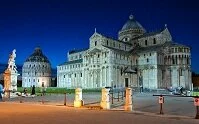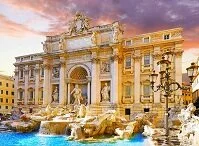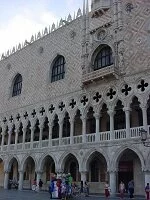
Town of Riomaggiore
Much of the Amalfi Coast towns were also founded at this time and their architecture is again fairly unique, despite the region's major draw, which is a combination of both the buildings and the setting itself.
During the Medieval ages, unlike in much of Europe, the people in Italy were still constructing marvelous structures, but Gothic or Romanesque buildings in Italy vastly differ from buildings in these same styles elsewhere in Europe. The most notable of these early Romanesque buildings are Piazza del Duomo (1000-1300s) in Pisa and Siena's old town, but there are dozens of others. Pisa, however was perhaps the most influential as aspects of this square can be seen in numerous Renaissance buildings built centuries later.

Piazza del Duomo in Pisa
Like so much Italian architecture, nearly every historic city in the country has at least one example of Romanesque architecture. A couple more examples of note include the city of Modena's Cathedral (1100s) along with a couple other buildings in the town center. Additionally, there are numerous buildings in the old towns of Parma and Cremona. Another odd Medieval building was the Castel del Monte (1200s) in Andria.
The Gothic style also flourished during the Medieval Ages, but like Romanesque architecture, Italian Gothic is fairly different from much of Europe's take on gothic and it arrived to the peninsula late, in the 1300s. Due to its late arrival and distance from the Gothic center in northern France, Italy has relatively few buildings in this style. A few buildings in Verona are good examples as are the Cathedral of Siena (1200-1300s) and Milan Cathedral (1300-1500s) both of which, like many Italian gothic structures, are Romanesque buildings with gothic facades. The Doge's Palace (1300-1400s) in Venice is also gothic in design, but is very distinct from other gothic forms, even within Italy, as Venice seemed to establish its own style of architecture.
Also during this time period a few Byzantine structures were erected, however the only one of note is St. Mark's Cathedral (Santo Marco; 1000-1600s) in Venice.
With the fall of the Byzantine Empire in 1453 many scholars from Constantinople (Istanbul) moved to Italy and with this migration came a great revival in education, thought, and creativity. This movement was called the Renaissance, meaning re-birth in Italian and this was the goal of the movement: returning to the glory of days past, particularly the days of the Roman Empire. With this movement came the architectural style of the same name.

Florence Cathedral
The Renaissance architectural style was developed in Florence with the essential help and support of the Medici family. This began with the creation of the dome over Florence Cathedral (which began in the early 1400s), which was the transition into this new style. Soon nearly all of Florence was being constructed in this style and soon much of Europe was also adopting it, in many cases by hiring Italian architects.
Among the early Renaissance works in Florence, are included the Ospedale degli Innocenti (1419-1451), the Medici Palace (1429-1460), and the Pazzi Chapel (1441-1460s). Outside of Florence the movement spread slowly during the 1400s, but some of the best examples of the style from this time include the Sant'Andrea Church (1472-1800s) in Mantua, the Ospedale Maggiore (begun in 1457) in Milan, Santa Maria delle Grazie (completed in 1490 & includes the famous "Last Supper" painting by Leonardo) in Milan, and the Santa Maria dei Miracoli (1481-1489) in Venice.
The shift to what is often considered the "High Renaissance" came in the 1490s. It was also during this time that the powerful Florentine leader, Lorenzo de'Medici died and many architects moved to Rome, where additional sponsors were seeking out artists and architects.

Trevi Fountain in Rome
The High Renaissance was short lived and many of these structures are located in either Vatican City or Rome. The Villa Farnesina (1509–11) and Palazzo Farnese (1517–89) in Rome were both built in this style. A couple villages near Rome were also the recipients of this style as Ferrara and Mantua both are contain numerous buildings in the Renaissance style, each of which has a couple structures from the High Renaissance.
The Mannerism or Late Renaissance period began in the 1520s. Unlike the High Renaissance, this form lasted longer and spread throughout Italy. There are examples in Florence (Laurentian Library (1525-1571)), Mantua (Palazzo del Te (1524-1534)), Rome (Villa Giulia (1550–55)), Venice (Loggetta (1537–1540) and Libreria Vecchia (1536–88) both on St. Mark's Square or Piazza), Turin (Residences of the Royal House of Savoy), Vicenza (Palladian Villas of the Veneto), and Urbino among others.

Doge's Palace
The Baroque period in Italy began in the late 1500s partially inspired by the Renaissance Church of the Gesu (1568) in Rome. Genoa was also a crossing ground between the two styles as the city became a seafaring power at the time and much of the historic center was built in late Renaissance and early Baroque style in the late 1500s and early 1600s. Likewise, the power of Turin continued through this period and the Residences of the Royal House of Savoy include a couple Baroque structures.
Like the Renaissance, there are numerous examples of Baroque buildings throughout Italy and nearly every town or city will have an example. A few of the more original or impressive buildings being the Church of Saint Andrew's at the Quirinal (1658-1670) and Church of Saint Charles at the Four Fountains (1634-1641), both in Rome, the Royal Palace in Caserta (1752), and the entire region of Val di Noto (Sicily), which was primarily constructed in the style after a devastating earthquake.
Neo-Classicism is also well represented in Italy, much of which was made in the form of gates or pillars to decorate a building's facade. This style ruled much of the late 1700s. By the late 1800s though, Italy had adopted modernism as the Industrial Revolution provided new building materials and techniques. The Crespi d'Adda (1800-1900s) in Capriate San Gervasio is a good example of an ideally constructed town to match the goals of the Industrial Revolution.